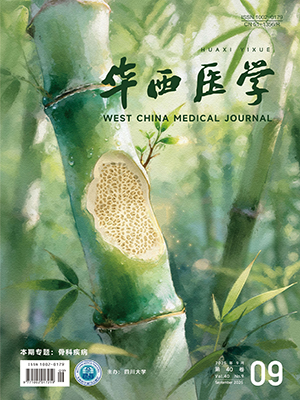| 1. |
Webb HE, Bugarel M, Den Bakker HC, <italic>et al</italic>. Carbapenem-resistant bacteria recovered from faeces of dairy cattle in the high plains region of the USA. PLoS One, 2016, 11(1): e0147363.
|
| 2. |
安军, 蔡挺, 张顺. 耐碳青霉烯类大肠埃希菌和肺炎克雷伯杆菌多重耐药研究进展. 现代实用医学, 2011, 23(3): 359-360.
|
| 3. |
Tängdén T, Giske CG. Global dissemination of extensively drug-resistant carbapenemase-producing Enterobacteriaceae: clinical perspectives on detection, treatment and infection control. J Intern Med, 2015, 277(5): 501-512.
|
| 4. |
尚红, 王毓三, 申子瑜. 全国临床检验操作规程. 4版. 北京: 人民卫生出版社, 2015: 3.
|
| 5. |
Clinical and Laboratory Standards Institute. Performance standards for antimicrobial susceptibility testing. CLSI Supplement M100. 27th ed. Wayne, PA: Clinical and Laboratory Standards Institute, 2017.
|
| 6. |
李莺, 丁云芳, 吴水燕, 等. 多重耐药肺炎克雷伯菌支气管肺泡灌洗液分离株耐药元件检测分析. 中华临床感染病杂志, 2014, 7(2): 150-156.
|
| 7. |
Hong SS, Kim K, Huh JY, <italic>et al</italic>. Multiplex PCR for rapid detection of genes encoding class A carbapenemases. Ann Lab Med, 2012, 32(5): 359-361.
|
| 8. |
Pasanen T, Koskela S, Mero S, <italic>et al</italic>. Rapid molecular characterization of <italic>Acinetobacter baumannii</italic> clones with rep-PCR and evaluation of carbapenemase genes by new multiplex PCR in Hospital District of Helsinki and Uusimaa. PLoS One, 2014, 9(1): e85854.
|
| 9. |
Wei J, Zou C, Wang D, <italic>et al</italic>. Genetic diversity and <italic>in vitro</italic> activity of ceftazidime/avibactam and aztreonam/avibactam against imipenem-resistant Enterobacteriaceae isolates in Southwest China: a single-centre study. J Glob Antimicrob Resist, 2020, 22: 448-451.
|
| 10. |
Zhang R, Liu L, Zhou H, <italic>et al</italic>. Nationwide surveillance of clinical carbapenem-resistant Enterobacteriaceae (CRE) strains in China. EBioMedicine, 2017, 19: 98-106.
|
| 11. |
胡付品, 郭燕, 朱德妹, 等. 2017年CHINET中国细菌耐药性监测. 中国感染与化疗杂志, 2018, 18(3): 241-251.
|
| 12. |
周仕丹, 刘春来, 杨润时, 等. 某院耐碳青霉烯类肠杆菌科细菌耐药基因分析. 中国感染控制杂志, 2019, 18(6): 495-504.
|
| 13. |
Zhang X, Chen D, Xu G, <italic>et al</italic>. Molecular epidemiology and drug resistant mechanism in carbapenem-resistant <italic>Klebsiella pneumoniae</italic> isolated from pediatric patients in Shanghai, China. PLoS One, 2018, 13(3): e0194000.
|
| 14. |
lp E, Perçin D, Colakoğlu S, <italic>et al</italic>. Molecular characterization of carbapenem-resistant <italic>Klebsiella pneumoniae</italic> in a tertiary university hospital in Turkey. Hosp Infect, 2013, 84(2): 178-180.
|
| 15. |
Calia C, Pazzani C, Oliva M, <italic>et al</italic>. Carbapenemases-producing <italic>Klebsiella pneumoniae</italic> in hospitals of two regions of Southern Italy. APMIS, 2017, 125(5): 491-498.
|
| 16. |
Satlin MJ, Chen L, Patel G, <italic>et al</italic>. Multicenter clinical and molecular epidemiological analysis of bacteremia due to carbapenem-resistant Enterobacteriaceae (CRE) in the CRE epicenter of the United States. Antimicrob Agents Chemother, 2017, 61(4): e02349-16.
|
| 17. |
王艳艳, 韩艳秋, 郭素芳, 等. 呼和浩特地区耐碳青霉烯类肠杆菌科细菌特征分析. 国际流行病学传染病学杂志, 2019, 46(3): 195-199.
|
| 18. |
韩仁如, 胡付品. 耐碳青霉烯类肠杆菌科细菌中OXA-48家族碳青霉烯酶分子流行病学研究进展. 中国感染与化疗杂志, 2019, 19(6): 687-690.
|
| 19. |
徐鹃鹃, 葛瑛. 碳青霉烯类耐药肠杆菌科细菌感染治疗研究进展. 中国感染与化疗杂志, 2019, 19(6): 680-686.
|
| 20. |
林迪, 孙长贵. 碳青霉烯类耐药肠杆菌科细菌的研究进展. 传染病信息, 2017, 30(5): 257-261, 271.
|
| 21. |
徐英春, 肖永红, 卓超, 等. 中国碳青酶烯类耐药肠杆菌科细菌的流行病学和防控策略. 中国执业医师, 2013, 10(4): 3-8.
|




